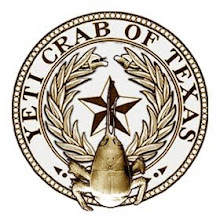You see the lone wanderer in the frozen Himalayas, on a quest, desperately seeking a shadowy being - a "fairy tale", some "half-remembered myth".
"--if such a shadowy being actually exists!"Wait... ..."Yet, he must exist..." Yeti must exist?
"Yet, he must exist! He must!
Um, no. Dr. Strange is looking for the "Ancient One", NOT yeti.
It's 1963, right during the thickest intensity of yeti fervor of the time, so I wouldn't be surprised if readers made a certain abominable association when getting to this sequence.
It seems likely, however, that Ditko and Lee were actually drawing on something other than the yeti myth as inspiration for Strange's quest for the Ancient One. They were channeling...
...Theosophy.
Madame Blavatsky, a white westerner and the movement's founder, said that ancient wisdom was taught to her by super-powered, highly-evolved Tibetan mystics hiding out in the Himalayas. She herself claimed to have the ability to create magical phenomena she learned from these Masters, and this was because of seven years she spent in Tibet under their tutelage. These elevated mystics were still in contact with her after she left; her teachers could speak to her from afar, teleport, or astrally project to her vicinity, to aid her in her heroic efforts to elevate humankind.
Sure, you could read Blavatsky's esoteric books and gain insight into the secret ancient wisdoms, but if you really wanted to have the magic powers, you had to go to the Himalayas and get taught by a Tibetan superhero dude, and it's unlikely he would even find you worthy enough anyway. Theosophy encourages extreme levels of discipline and being-a-good-person-ness (um, anyone know a better word for that?). Theosophy's "Masters" were foes to anyone performing black magic, and any shortcuts to the magic powers they could wield were strictly forbidden.
The Ancient One of the comic book Dr. Strange is very similar to one of Blavatsky's Masters and very likely owes his origins to them. Many of the Marvel superhero's powers, such as traveling on the Astral Plane and telepathy, were introduced and popularized in the west by Theosophy, originally.
In Western popular culture (thanks to Theosophy), magic comes from some secret Asian monk dude in the Himalayas. Besides Dr. Strange, many super-heroes gained their powers by getting trained in mystic Tibet See: Amazing-Man, The Flame, Wonder Man, The Green Lama, and even Iron Fist (soon to be a Netflix TV show)- a white dude who travels to the mystical city of K'un-Lun in Tibet to be trained by Asians to get super-powers.
It was Dr. Strange, however, that helped fuel the 1960's counterculture's fascination with Eastern mysticism, just as folks in the late 19th century had their interest sparked by Blavatsky's tall tales of the Masters.
Of course, Theosophy's teachings and the idea of the Masters was itself a hodgepodge of inspirations from more authentic Eastern religious sources. But one can pretty easily, I think, draw a line from a western superhero comic to a western religious movement that made a dramatic mark on the western popular consciousness. How you get from A to C is B.
And B is for Blavatsky.
Let's take another look at this 'shadowy being', this 'half-remembered myth' hiding in the Himalayas, this ancient one known as the Ancient One from Marvel's Dr. Strange:
News: Tilda Swinton has been cast as the Ancient One in the Doctor Strange live-action motion picture, arriving in theaters on November 4th.
Next week's theme: Rule 63.


















No comments:
Post a Comment